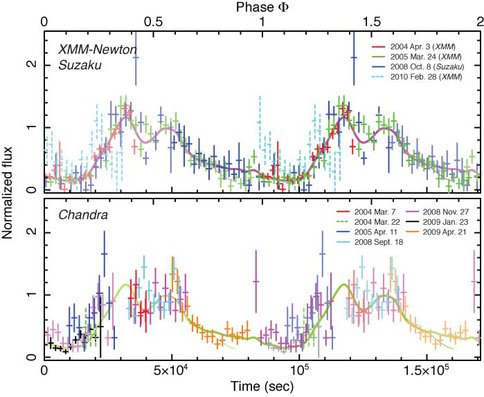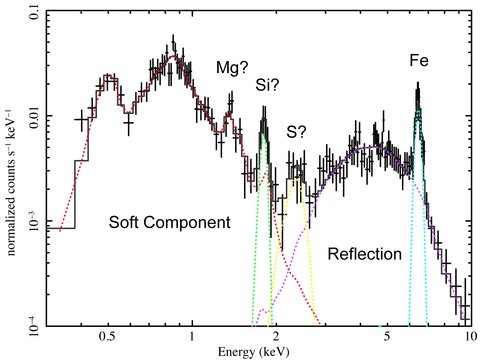2012 Annual Science Report
 NASA Goddard Space Flight Center
Reporting | SEP 2011 – AUG 2012
NASA Goddard Space Flight Center
Reporting | SEP 2011 – AUG 2012
Discovery of a Periodicity in X-Ray Emission From an Erupting Young Star and Diffuse Emission in the Carina Star Forming Region
Project Summary
High-energy photons in the young stellar environment are known to be important in stimulating chemical reactions of molecules and producing pre-biotic materials. In this reporting period, we approached this problem from two directions: systematic study of X-ray light curves of a young star that experienced an episodic outburst and spectral characteristics of diffuse X-ray emission from the Carina massive star-forming region. We discovered a periodicity of a day in the highly elevated X-ray emission from a protostar for the first time. This result was press-released from NASA/GSFC, ESA and NAI. We also found a strong X-ray emission line in a diffuse spectrum around Eta Carinae, which may require a non-thermal process such as charge exchange.
Project Progress
High-energy photons in the young stellar environment are known to be important in stimulating chemical reactions of molecules and producing pre-biotic materials that might later be incorporated into comets. Observational tests are sorely needed to assess the significance of such processing for Astrobiology, and to guide development of theoretical models for chemical evolution in proto-planetary environments. In this reporting period, we approached this problem from two directions: X-ray emission mechanism of a young star that experienced an episodic outburst and spectral characteristics of the diffuse X-ray emission in the Carina star forming region.
Location and size of the X-ray emitting plasma associated with protostars is an important piece of information in understanding how the high energy activity works in the earliest phase of the solar-type stars. We discovered a periodicity of ∼1 day in the highly elevated X-ray emission from the protostar V1647 Ori during its two recent multiple-year outbursts of mass accretion (Figure 1, Hamaguchi et al. 2012). This would be the first discovery of a periodicity in the X-ray emission from a protostar. The periodicity is indicative of protostellar rotation at near-breakup speed. Modeling of the phased X-ray light curve indicates that the high-temperature (∼50 MK), X-ray-emitting plasma, which is most likely heated by accretion-induced magnetic reconnection, resides in dense (>5×10 cm−3), pancake-shaped magnetic footprints where the accretion stream feeds the newborn star. The sustained X-ray periodicity of V1647 Ori demonstrates that such protostellar magnetospheric accretion configurations can be stable over timescales of years. This result was press-released from multiple institutes such as NASA/GSFC, ESA and NAI on July 3 2012 and covered by many web newspapers and journals.
Cold medium in the interplanetary space, such as comets, emits X-rays probably through exchange of electrons between their cold neutral gas and ionized particles in the solar winds. Fundamentally, such processes could occur at any location where the hot and cold gases meet. We have studied two regions in the massive star-forming region, Carina nebula, observed with the Chandra and Suzaku X-ray observatories. First, we continued from the previous reporting period studying diffuse X-ray emission from a south-west region of the Carina nebula with the Suzaku observatory. The spectrum shows strong enhancement in the soft energy band below 0.4 keV, which may require smaller absorption column to the region than to the central region and the eastern tip region of the Carina nebula. Second, we studied in detail extended X-ray emission from the outer lobe of Eta Carinae, dubbed the Homunculus nebula (HN), with Chandra. X-ray spectra of the HN (Figure 2) above 3.5 keV varies with time, consistent with reflection of X-ray emission from the central source at the HN. The X-ray emission below does not vary, which would originate from diffuse emission surrounding the HN. The spectra show a strong emission line at ~ 1.79 keV, which might require a non-thermal process such as charge exchange.
Figure 1: Periodic X-ray light curves of V1647 Ori.
Figure 2: Chandra spectrum of the Homunculus nebula.
Publications
-
Hamaguchi, K., Grosso, N., Kastner, J. H., Weintraub, D. A., Richmond, M., Petre, R., … Principe, D. (2012). X-RAYING THE BEATING HEART OF A NEWBORN STAR: ROTATIONAL MODULATION OF HIGH-ENERGY RADIATION FROM V1647 Ori. The Astrophysical Journal, 754(1), 32. doi:10.1088/0004-637x/754/1/32
-
Hornbeck, J. B., Grady, C. A., Perrin, M. D., Wisniewski, J. P., Tofflemire, B. M., Brown, A., … Lauroesch, J. T. (2011). PDS 144: THE FIRST CONFIRMED Herbig Ae-Herbig Ae WIDE BINARY. The Astrophysical Journal, 744(1), 54. doi:10.1088/0004-637x/744/1/54
-
Huenemoerder, D. P., Oskinova, L. M., Ignace, R., Waldron, W. L., Todt, H., Hamaguchi, K., & Kitamoto, S. (2012). ON THE WEAK-WIND PROBLEM IN MASSIVE STARS: X-RAY SPECTRA REVEAL A MASSIVE HOT WIND IN μ COLUMBAE. The Astrophysical Journal, 756(2), L34. doi:10.1088/2041-8205/756/2/l34
-
PROJECT INVESTIGATORS:
-
PROJECT MEMBERS:
Kenji Hamaguchi
Co-Investigator
Robert Petre
Co-Investigator
-
RELATED OBJECTIVES:
Objective 2.2
Outer Solar System exploration

